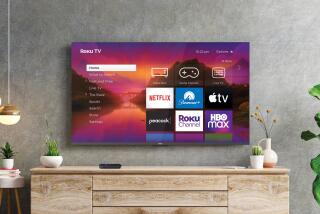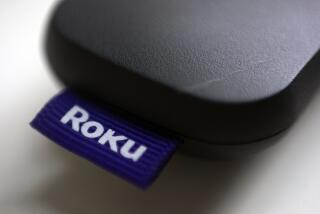Start-Up Roku to Launch Digital Media Player for High-Definition TVs
- Share via
PALO ALTO — They have no receptionist and only paper name signs taped to their office doors, but the 20 employees working out of a nondescript building on a leafy, quiet street here are ready to challenge tech giants in the digital media market.
Led by the man who helped spark a revolution in television by creating ReplayTV, the first digital video recorder, the start-up Roku is developing products to make the living room, and not the PC, the showcase for all digital content, from photos to music.
Roku founder and Chief Executive Anthony Wood knows big-name companies, such as Microsoft Corp. and Hewlett-Packard Co., already are attempting to do the same with so-called media servers or media receivers -- devices that allow users to take content stored on their computers and play it on their televisions or stereos.
None of those kinds of products have taken off yet, and the ambitious but soft-spoken 37-year-old serial entrepreneur thinks his latest company can do better.
After a year in secret development, Roku unveils its business and launches its first product today, the Roku HD1000.
It’s the first digital media player to be designed for high-definition televisions, which are gaining in popularity as prices drop. The HD1000 can play slide shows, video or music files from its four built-in memory card slots or play files streamed from a computer through an Ethernet network connection.
“By trying to establish a beachhead in a large but rapidly growing market, we could own it, because there’s no competition today,” Wood said during an interview in his office, sparsely decorated with memorabilia from his past start-ups. “It’s called getting in early on a trend.”
With a price tag of $499, Roku is targeting high-end consumers, those already spending $3,000 or more on an HDTV set.
In the United States, about 2.5 million digital TV sets -- mostly HDTV-equipped -- were sold last year. That sales figure should double by 2004, according to the Consumer Electronics Assn.
“The Roku product is a smart play for the early adopters,” said Larry Gerbrandt, senior analyst at Kagan World Media Group. “This opens up a world of functionality for HDTVs.”
Gerbrandt and other industry analysts think Roku could successfully hit a niche market. Whether it could succeed beyond that is up for debate, but Wood’s track record of creating cutting-edge products bodes well for Roku.
“Anthony Woods has introduced the right products at the right time, and it looks like he’s doing it again with Roku,” said Sean Badding, an analyst with Carmel Group.
Wood named the company Roku because it is his sixth company, and the word means six in Japanese.
Wood’s entrepreneurial days started in high school in 1983, when he formed Aw Software, selling text-based adventure games and an online bulletin-like program he wrote for TRS-80 computers. The teenage Wood netted about $1,200.
Three years later, while at Texas A&M; University, Wood started SunRize, selling sound digitizer products for Amiga computers. He raked in $100,000 and bought a used Porsche before quitting the business to finish his electrical engineering degree.
After graduating, he moved to Silicon Valley in 1990 and reincarnated the company as Sunrize Industries, a supplier of digital audio editing products that annually earned more than $1 million.
In 1995, as the Internet was taking off, Wood founded iBand Inc., which developed the popular Web-authoring tool Dreamweaver. Wood sold iBand to Macromedia Inc. for $36 million, and served as Macromedia’s vice president of Internet authoring before starting ReplayTV Inc. in 1997.
The idea for ReplayTV stemmed from Wood’s frustration with repeatedly missing “Star Trek” episodes. He came up with the digital video recorder, or DVR, which allows users to record shows onto a hard disk drive and pause or fast-forward live television.
ReplayTV, Wood’s best-known company yet, beat rival TiVo Inc. by a few months with its DVR in 1999.
Wood sold ReplayTV in 2001 to Sonicblue Inc. for $125 million. During his one-year stint at Sonicblue, Wood oversaw the development of the ReplayTV models that featured automatic skipping of television commercials and the ability to send recorded programming over the Internet -- features that landed Sonicblue in court against Hollywood.
Crushed by the legal costs and mounting debt, Sonicblue sold its jewels in a bankruptcy auction in April. ReplayTV and its Rio audio player line went for $36.2 million to D&M; Holdings Inc., the parent of the Denon and Marantz home electronics brands.
D&M; had outbid Wood’s $17-million offer for his old company.
As ReplayTV and TiVo continued to battle growing competition from larger rivals and cable operators building DVR functions into their set-top boxes, Wood said he could not stay on the sidelines.
“I’m not doing it for the money, but I really enjoy building things,” Wood said. “There’s so much opportunity in the shift to digital media, and I don’t think the products out there are being done well.”
The Roku HD1000 is based on an open Linux-based platform, which Wood hopes will encourage third-party developers to build applications for it. To start, Roku also is selling $69 memory cards filled with classic paintings, nature and aquarium images, turning the HDTV set into an art canvas.
Roku also seeks to license its software to other set-top-box and television makers.
The company would break even by selling 10,000 units but hopes to become profitable by selling at least 20,000 units within a year, Wood said.
More products are planned. Wood would not divulge many details, but he said a future product would include a hard disk drive with DVR capabilities.





